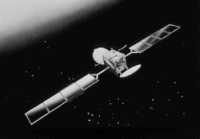
Photo from wikipedia
The recent availability on the market of industrial, reliable, ultrashort pulse lasers (UPLs) delivering hundreds of watts has opened the possibility for this technology to significantly increase the machining throughput… Click to show full abstract
The recent availability on the market of industrial, reliable, ultrashort pulse lasers (UPLs) delivering hundreds of watts has opened the possibility for this technology to significantly increase the machining throughput and address an ever-larger number of industrial applications. Nevertheless, heat accumulation phenomena are observed as soon as the average power P exceeds tens of watts, compromising the peculiar UPL machining quality. In this case, for a given machining process, it is determinant to implement a specific beam engineering strategy to mitigate thermal impacts, exploit the available P, and increase the throughput. Here, we show the results obtained in micro-cutting with an IR, femtosecond laser delivering Pmax = 100 W, at a maximum repetition rate of fmax = 10 MHz. The beam is first delivered through an innovative, fast, galvo scanner enabling a maximum speed of 20 m/s. A positive impact of high speed is observed for both the removal efficiency at high fluence and the machining quality at high power. In a second step, the beam is also split into three sub-beams enabling parallel processing. The authors show that, in this way, it is possible to fully exploit P, reduce the time taken by a factor of 10, and keep unchanged machining quality.
Journal Title: Journal of Laser Applications
Year Published: 2020
Link to full text (if available)
Share on Social Media: Sign Up to like & get
recommendations!